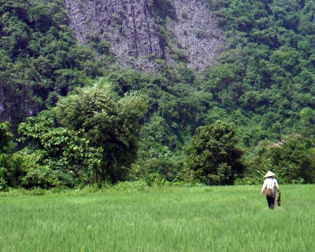Food Studies features the voices of 11 volunteer student bloggers from a variety of different food- and agriculture-related programs at universities around the world. You can explore the full series here.
 This summer, my girlfriend and I went backpacking in South East Asia. We visited Thailand, Cambodia, and Laos. On our first bus ride I could already tell this trip was different — one year of plant science different. Among all the stunning sights, I was immediately captivated by the vast rice paddies. We visited during the rainy season and the rice stood green and tall, rising about 50 centimeters (20 inches) out of the flooded fields. It was really quite beautiful, but I was also intrigued by this unfamiliar way of agriculture.
This summer, my girlfriend and I went backpacking in South East Asia. We visited Thailand, Cambodia, and Laos. On our first bus ride I could already tell this trip was different — one year of plant science different. Among all the stunning sights, I was immediately captivated by the vast rice paddies. We visited during the rainy season and the rice stood green and tall, rising about 50 centimeters (20 inches) out of the flooded fields. It was really quite beautiful, but I was also intrigued by this unfamiliar way of agriculture.
As is the case with most other grains, rice cultivation hasn’t changed much conceptually ever since it first began. The most recent substantial technological advancement in grains came in the 1960s, when the “Green Revolution,” led by agronomist Norman Borlaug, transferred high-yield cultivars, pesticides, and fertilizers to less industrialized countries like India. As I understand it, the implementation of these techniques and plant hybrids in India helped stop famine and saved millions of people from starvation. It brought agriculture as we know it today to the developing world.
But this summer, as our bus drove through northern Laos, it seemed that men and women wearing pointy straw hats had been growing rice the exact same way, backs bent double, for thousands of years. In class last year, I had studied so many different methods of irrigation, but this type of irrigation — the massive flooding of hundreds of miles of fields — is something you cannot imagine until you see it with your own eyes. In class, our discussion had focused on technological advancements in agriculture; in Laos I saw very little mechanized cultivation, and that also puzzled me — everything was being done by hand.
Second to corn, rice is the most cultivated crop in the world. I read once that 90 percent of all agricultural land in Cambodia is devoted to growing rice. According to the Food and Agriculture Organization of the United Nations (FAO), rice supplies between 50 and 80 percent of caloric intake in the Asia-Pacific region and around 20 percent worldwide. The FAO also believes that annual demand for rice in that region will rise from 524 million tons to 700 million tons by the year 2025.
As our bus sped around the curves on the jungle road from Vang Vieng to Luang Prabang, I also couldn’t help but notice the use of slash-and-burn practices. For me, this clearly illustrated the tension between local people’s pressing need to produce food and livelihood for their families, and the longer-term, ever-growing environmental problems to which so many agricultural practices contribute. Slash-and-burn has been a problem for decades in Laos and only recently has the government begun to take steps towards abolishing it.
Demand for food is on the rise worldwide, but this demand is causing global environmental dilemmas. One guest speaker at my university cited the famed scholar and political economist Thomas Malthus, who suggested in the early 19th century that “population increase is exponential but increase in food production is linear” — thus concluding the world must ultimately starve. Can we prove him wrong?
The “Green Revolution” already showed that we can increase yields dramatically and give starving people the tools with which to feed themselves. However, it was not without its share of controversy, with many critics arguing that it forced farmers to become dependent on environmentally harmful pesticides, chemical fertilizer and seed companies. As I look forward to returning to the classroom and greenhouses this fall, I can’t help but think of rising sea-levels, population growth, and the flooded fields and burned forests of Laos. Will there be a next revolution that boosts yields sustainably, and holds the key to the next 50 years? I’m here to find out.




